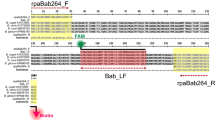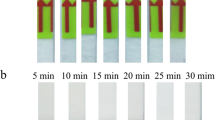Abstract
A real-time fluorescence resonance energy transfer PCR combined with melting curve analysis was developed for differentiating Brugia malayi and Brugia pahangi DNA in host blood using one set of primers and fluorophore-labeled hybridization probes specific for HhaI repetitive DNA. The differentiation of both species was based on their melting temperatures (Tm). The mean Tm ± SD of B. malayi and B. pahangi were 56.18 ± 0.21 and 52.49 ± 0.07, respectively. The method was used for the molecular detection of B. pahangi in infected dog blood samples. The diagnostic sensitivity, specificity, accuracy, and positive and negative predictive values of this method were 100%. The detected mean difference of the Tm might allow the simple discrimination of two related species. This method is fast, sensitive, allows for a high throughput, can be performed on very small volumes, and has potential for diagnosis of B. pahangi-infected dogs in endemic areas as well as for large epidemiological investigations.

Similar content being viewed by others
References
Areekit S, Khuchareontaworn S, Kanjanavas P, Sriyapai T, Pakpitchareon A, Khawsak P, Chansiri K (2009) Molecular genetics analysis for co-infection of Brugia malayi and Brugia pahangi in cat reservoirs based on internal transcribed spacer region 1. Southeast Asian J Trop Med Public Health 40:30–34
Chungpivat S, Taweethavonsawat P (2008) The differentiation of microfilariae in dogs and cats using Giemsa’s staining and the detection of acid phosphatase activity. J Thai Vet Pract 20:47–55
Dissanaike AS (1979) Zoonotic aspects of filarial infections in man. Bull World Health Organ 57:349–357
Intapan PM, Thanchomnang T, Lulitanond V, Maleewong W (2009) Rapid detection of Wuchereria bancrofti and Brugia malayi in mosquito vectors (Diptera: Culicidae) using a real-time fluorescence resonance energy transfer multiplex PCR and melting curve analysis. J Med Entomol 46:158–164
Lulitanond V, Intapan PM, Pipitgool V, Choochote W, Maleewong W (2004) Rapid detection of Wuchereria bancrofti in mosquitoes by LightCycler polymerase chain reaction and melting curve analysis. Parasitol Res 94:337–341
Lyon E, Wittwer CT (2009) LightCycler technology in molecular diagnostics. J Mol Diagn 11:93–101
Mak JW, Yen PK, Lim KC, Ramiah N (1980) Zoonotic implications of cats and dogs in filarial transmission in Peninsular Malaysia. Trop Geogr Med 32:259–264
McReynolds LA, DeSimone SM, Williams SA (1986) Cloning and comparison of repeated DNA sequences from the human filarial parasite Brugia malayi and the animal parasite Brugia pahangi. Proc Natl Acad Sci USA 83:797–801
Nuchprayoon S, Junpee A, Poovorawan Y, Scott AL (2005) Detection and differentiation of filarial parasites by universal primers and polymerase chain reaction–restriction fragment length polymorphism analysis. Am J Trop Med Hyg 73:895–900
Palmieri JR, Ratiwayanto S, Masbar S, Tirtokusumo S, Rusch J, Marwoto HA (1985) Evidence of possible natural infections of man with Brugia pahangi in South Kalimantan (Borneo), Indonesia. Trop Geogr Med 37:239–244
Rao RU, Weil GJ, Fischer K, Supali T, Fischer P (2006) Detection of Brugia parasite DNA in human blood by real-time PCR. J Clin Microbiol 44:3887–3893
Sivanandam S, Fredericks HJ (1966) The “Innenkorper” in differentiation between the microfilariae of Brugia pahangi and B. malayi (sub-periodic form). Med J Malaya 20:337–338
Sucharit S, Harinasuta C, Viraboonchai S, Smithanonda S (1975) The differentiation of Brugia malayi, B. pahangi, B. tupaiae and Wuchereria bancrofti. Southeast Asian J Trop Med Public Health 6:549–554
Thanchomnang T, Intapan PM, Lulitanond V, Choochote W, Manjai A, Prasongdee TK, Maleewong W (2008) Rapid detection of Brugia malayi in mosquito vectors using a real-time fluorescence resonance energy transfer PCR and melting curve analysis. Am J Trop Med Hyg 78:509–513
World Health Organization (1991) Basic laboratory methods in medical parasitology. World Health Organization, Geneva
Yen PK, Mak JW (1978) Histochemical differentiation of Brugia, Wuchereria, Dirofilaria and Breinlia microfilariae. Ann Trop Med Parasitol 72:157–162
Acknowledgments
This study was supported by grants from the Office of the Higher Education Commission (grant funded under the Strategic Scholarships for Frontier Research Networks), the Thailand Research Fund, and the Research and Technology Transfer Affairs and the Faculty of Medicine (research grant Comm51201), Khon Kaen University, Thailand. The authors wish to thank Wej Choochote for his technical support. All investigations in this study complied with current Thai laws.
Conflict of interest statement
No conflict of interest is declared.
Author information
Authors and Affiliations
Corresponding author
Rights and permissions
About this article
Cite this article
Thanchomnang, T., Intapan, P.M., Chungpivat, S. et al. Differential detection of Brugia malayi and Brugia pahangi by real-time fluorescence resonance energy transfer PCR and its evaluation for diagnosis of B. pahangi-infected dogs. Parasitol Res 106, 621–625 (2010). https://doi.org/10.1007/s00436-009-1706-4
Received:
Accepted:
Published:
Issue Date:
DOI: https://doi.org/10.1007/s00436-009-1706-4




